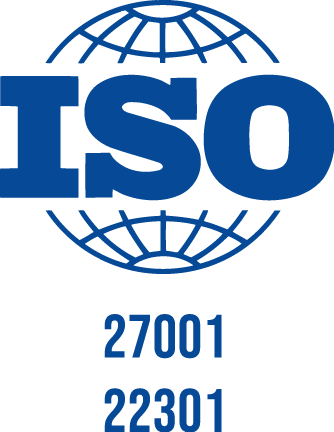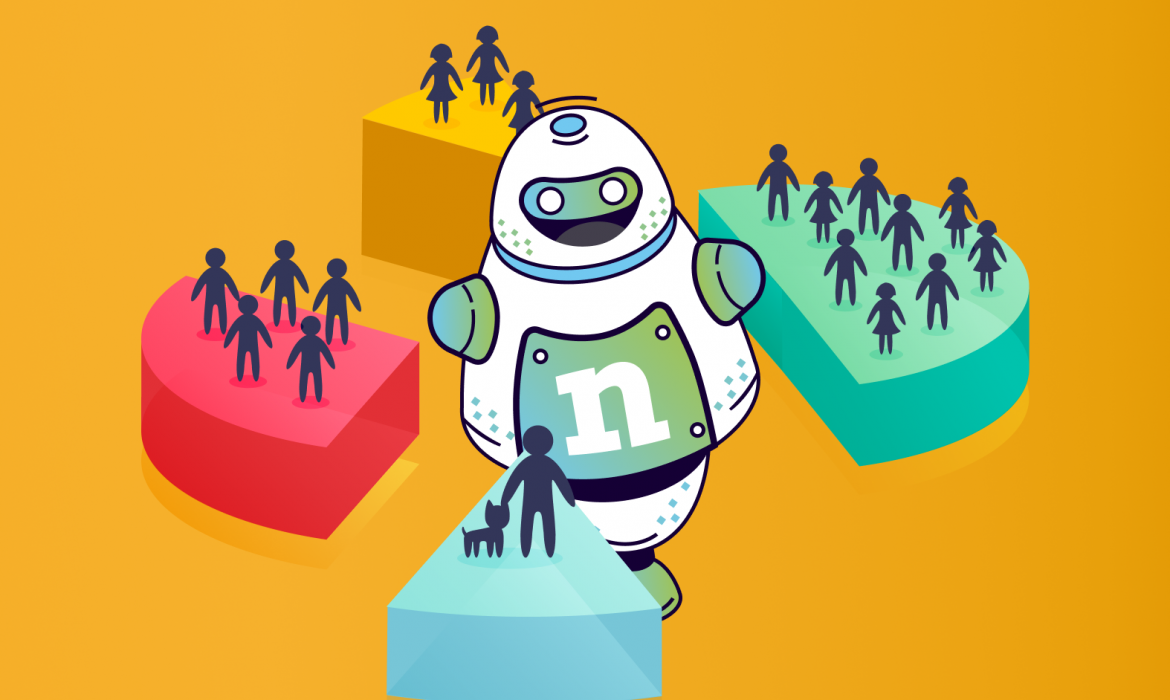
In the world of customer-focused strategies, businesses are adopting a smart approach called “Predictive Segmentation” to better connect with their customers. Unlike traditional methods like behavioral or demographic segmentation, Predictive Segmentation uses advanced analytics and AI to predict what customers might do in the future. This blog post will explain how businesses use predictive analytics to understand customer behavior, predict upcoming trends, and create personalized strategies. It’s a way for businesses to meet current needs and stay in tune with what customers will likely want down the road.
Let’s dive into the practical side of Predictive Segmentation and see how it helps businesses stay ahead in a constantly changing market.
Predictive Segmentation
What is Predictive Segmentation?
Predictive segmentation is a marketing strategy that divides a target audience into segments based on predictive analytics and machine learning algorithms. Instead of relying solely on traditional demographic or behavioral segmentation, predictive segmentation leverages advanced analytics to identify patterns and trends within large datasets. This allows marketers to anticipate future behavior and tailor their campaigns more effectively.
Why is Predictive Segmentation Important?
Predictive segmentation is important for businesses seeking ways to maximize the impact of their marketing efforts. By harnessing advanced analytics and machine learning practices, predictive segmentation goes beyond traditional demographic or behavioral segmentation, allowing companies to anticipate future customer behaviors and preferences.
This approach enables marketers to tailor their campaigns precisely, delivering personalized messages to specific audience segments. The result is improved targeting, increased campaign effectiveness, and optimized resource allocation. Predictive segmentation enhances the overall customer experience by providing more relevant interactions and gives businesses a competitive edge in rapidly evolving markets. Its real-time adaptability and ability to reduce marketing waste contribute to a more efficient and responsive marketing strategy, fostering customer loyalty and driving long-term success.
Benefits of Predictive Segmentation
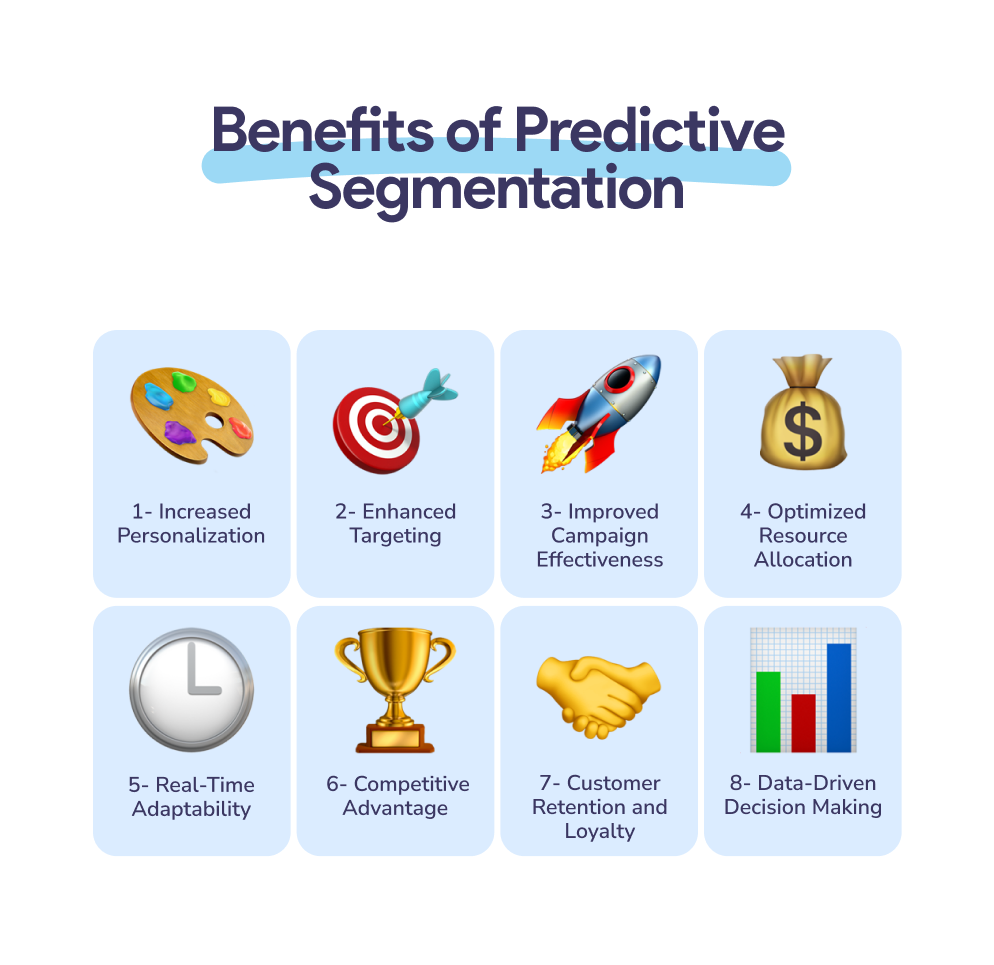
Predictive segmentation is a powerful tool to optimize businesses’ marketing efforts, drive customer engagement, and gain a competitive edge in today’s dynamic business environment. The ability to precisely anticipate and respond to customer behavior contributes to more effective and efficient marketing strategies, ultimately leading to improved business outcomes. Let’s review some benefits of utilizing predictive segmentation for businesses aiming to enhance marketing effectiveness and overall business performance.
1. Increased Personalization
Predictive segmentation enables businesses to understand individual customer behaviors and preferences, facilitating the delivery of highly personalized marketing messages and offerings. This enhances the overall customer experience and increases the likelihood of positive responses.
2. Enhanced Targeting
Predictive segmentation allows businesses to focus their marketing efforts on the most promising audience segments by identifying high-value customer segments or those with a higher likelihood of conversion. This leads to more effective targeting and resource allocation.
3. Improved Campaign Effectiveness
Predictive segmentation helps businesses stay ahead of market trends and changes in customer behavior. This adaptability allows for optimizing marketing campaigns in real time, resulting in increased effectiveness and better outcomes.
4. Optimized Resource Allocation
Businesses can allocate their marketing resources more efficiently by concentrating on segments predicted to yield higher returns. This optimization leads to cost savings and a more favorable return on investment (ROI).
5. Real-Time Adaptability
Predictive segmentation models are dynamic and responsive to changes in customer behavior, allowing businesses to adapt their strategies in real-time. This flexibility is valuable in industries with rapidly evolving consumer preferences.
6. Competitive Advantage
Companies that effectively leverage predictive segmentation gain a competitive advantage by staying attuned to customer needs and market trends. This agility enables them to respond quickly to changing conditions and deliver compelling offerings to their target audience.
7. Customer Retention and Loyalty
Predictive segmentation helps businesses identify opportunities for proactive engagement, such as predicting potential churn or identifying cross-selling opportunities. This fosters customer loyalty and strengthens long-term relationships.
8. Data-Driven Decision Making
Predictive segmentation relies on data-driven insights and analytics, empowering businesses to make informed decisions based on a deeper understanding of their target audience. This data-driven approach enhances strategic decision-making across various marketing initiatives.
How Predictive Segmentation Works
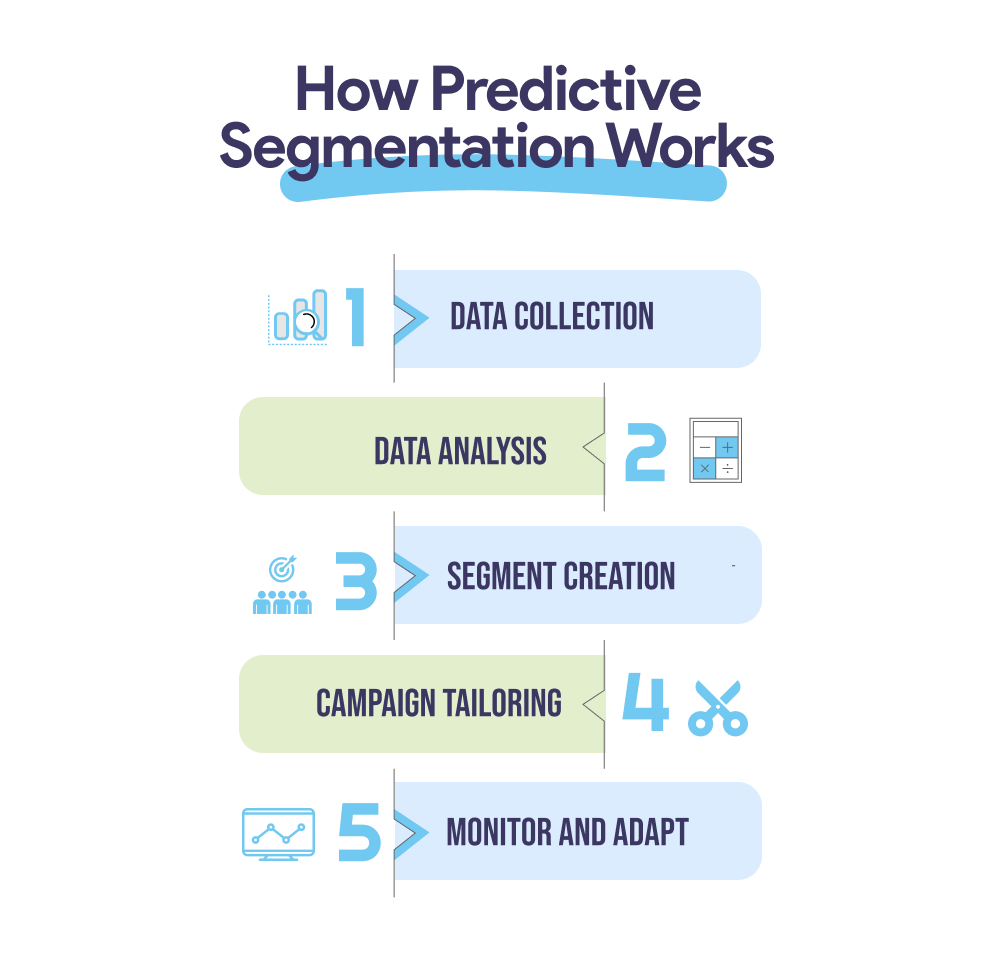
The process typically includes data collection, analysis, and the creation of segments based on predictions. Here’s a general overview of how predictive segmentation works:
1. Data Collection
Gather a diverse set of data, including customer interactions, purchase history, demographic information, online behavior, and any other relevant data sources.
2. Data Analysis
Analyze the data using advanced analytics and machine learning algorithms to identify patterns and trends. This allows for more accurate predictions of future customer behavior.
3. Segment Creation
Create segments based on customers’ predicted behavior and preferences. These segments may be based on factors such as the likelihood to convert or customer lifetime value.
4. Campaign Tailoring
Tailor marketing campaigns to each segment based on their predicted behavior and preferences. This allows for more personalized and compelling messaging.
5. Monitor and Adapt
Continuously monitor the effectiveness of campaigns and adapt strategies in real-time based on changes in customer behavior or market trends. This allows for a more responsive and adaptable marketing strategy.
Types of Predictive Segmentation With Examples
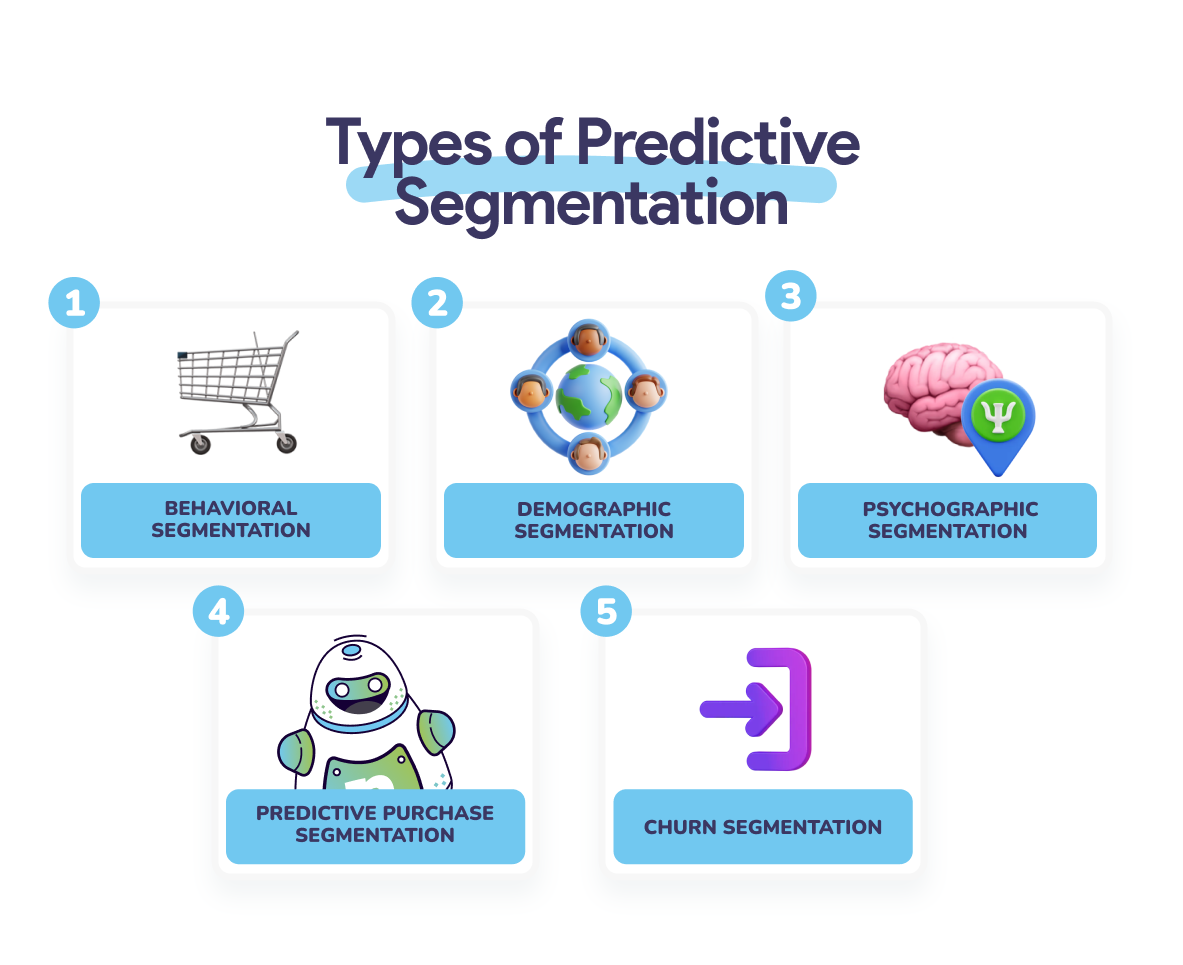
A business can use various types of predictive segmentation to tailor their marketing efforts to specific groups of customers. Each type of segmentation has its unique benefits and can be used to target specific groups of customers with relevant marketing messages and offers. Some of the most common types include:
1. Behavioral Segmentation
This type of segmentation divides customers based on their past behavior, such as purchase history, website interactions, and engagement with marketing campaigns. For example, an online streaming service can predict user preferences based on viewing habits, content ratings, and time spent on different genres. Based on this information, the platform can segment users into categories based on their viewing habits and preferences. Using this segment, the brand can then proactively recommend content that aligns with each user’s predicted future viewing behavior. You can visit our latest article on behavioral segmentation for more information, whether predicted or not.
2. Demographic Segmentation
This type of segmentation divides customers based on demographic characteristics, such as age, gender, income, and location. A mobile carrier brand can be an example of a predictive demographic segmentation. For instance, the brand can identify segments of young professionals and predict their increasing data usage over time. The brand can then tailor future service plans and offers to meet the anticipated needs of this demographic group.
3. Psychographic Segmentation
This type of segmentation divides customers based on their personality traits, values, and lifestyle preferences. An online retailer brand can predict customers’ future purchasing behaviors based on their psychographic profiles, such as values and lifestyle preferences. For example, the brand can identify segments of environmentally conscious shoppers, cruelty-free & vegan shoppers, and anticipate their interest in sustainable, vegan, cruelty-free products. The brand can then launch targeted marketing campaigns and product lines to align with the predicted future preferences of this segment.
4. Predictive Purchase Segmentation
This type of segmentation divides customers based on their predicted likelihood to make purchases in the future. An e-commerce platform can utilize machine learning algorithms to analyze a customer’s browsing history and behavior, cart abandonment patterns, and response to sales events and promotions. Based on this analysis, the platform can predict the future purchase likelihood of each customer and segment them into categories like “High Potential Buyers,” “Moderate Buyers,” and “Low Potential Buyers.” The brand can tailor promotional efforts and marketing campaigns to maximize sales from each segment.
5. Churn Segmentation
This type of segmentation divides customers based on their predicted likelihood to churn or stop doing business with the company. A subscription-based software service can predict which customers risk churning based on decreased usage, lack of engagement, or activity. The brand can then segment users into “High Churn Risk,” “Moderate Churn Risk,” and “Low Churn Risk” categories. Targeted retention strategies such as personalized communication, special offers, and 1:1 meetings with the Success Managers & Product Teams can be implemented in each segment. On the other hand, a streaming service can predict likely-to-churn subscribers by analyzing their last online activity, time spent watching, rankings, ratings, and feedback.
How Netmera Helps
Well, we all now understand what predictive segmentation is. And it is time to discover how Netmera can help you on your journey for advanced segmentation. We use AI algorithms to dig into real-time user events like purchases, clicks, and notifications. The result? Netmera spots patterns and correlations, adapting and learning from every interaction. It’s the backbone of our AI-based segments, making marketing smarter and more effective.
With Netmera, you don’t guess the future; you know it. You can easily create AI-based segments for your marketing campaigns, whether tackling churn or boosting conversions. Netmera gives you the tools to understand user behavior and stay ahead in marketing. Don’t forget to contact us to discuss what we can achieve together or to get more information.
